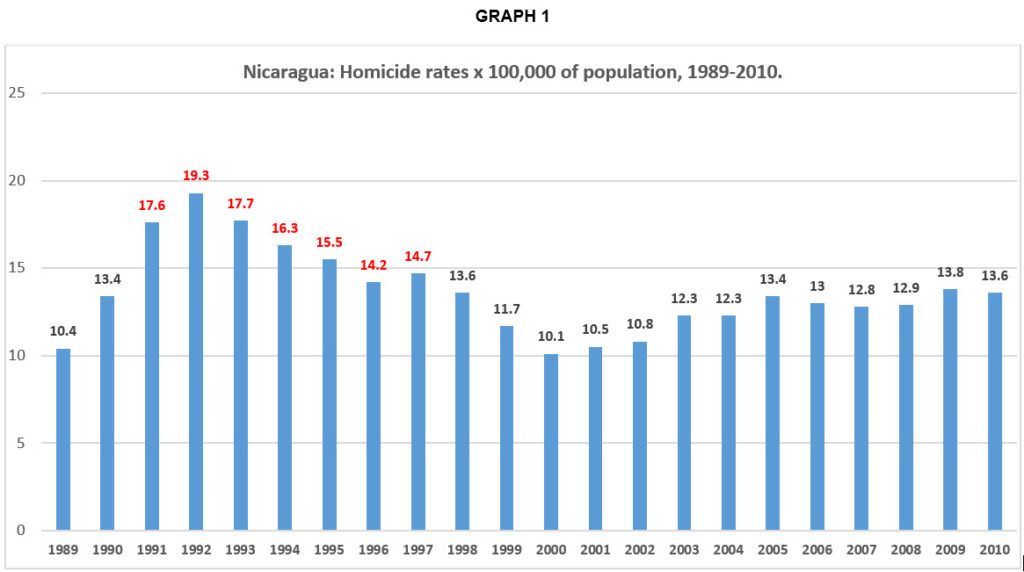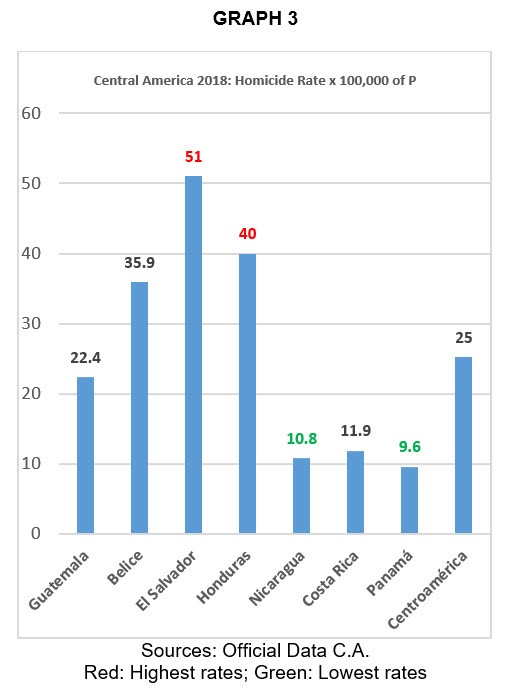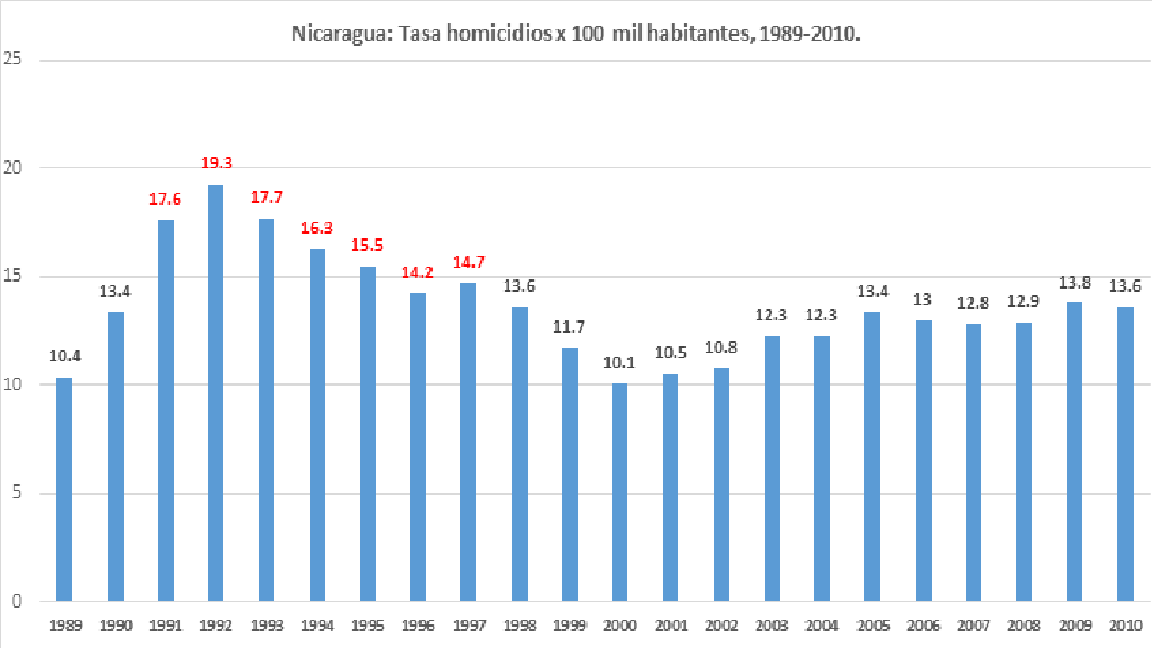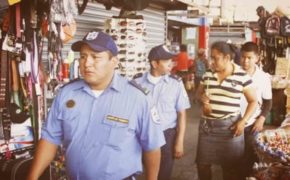Citizen Security: Coexistence and peace
Managua, 16th March, 2019
Francisco Javier Bautista Lara
Citizen Security: Coexistence and peace
(Data and reflections about Nicaragua and Central America 2018)
[Non official translate]
“There’s no way to peace, there is onlypeace”. Mahatma Gandhi
Citizen security, understood as a real risk (objective field: probability to be affected by a crime), or being victim of any crime (subjective field: fed by fear, distrust, state of mind, disinformation, manipulation, etc.). Nicaragua, during the last 40 years, the most negative years was at the middle of 90s, and the most positive year, besides 1981-1982, was 2017, reaching a proven enviable position in Central and Latin America.
The most accepted target indicator worldwide, it is the homicide rate regarding to the population. It the most dangerous crime, threatens human life. In addition to this, we can consider threats or aggravated robbery, affecting property, and they involve danger for people, exercising physical violence by the author, with a knife or a gun. The first one, has insignificant “dark figure”, and the second, used to register a “non-report” higher, setting a deficient data.
The perception or sensation of security, can be disturbed, mainly nowadays, because the growth and urban disorder, emotional, cultural, socioeconomic and diverse political reasons, prejudices and because the irresponsibility of the conventional and virtual media, and social media, that easily -with lack of prudence and work ethic-, can spread fear, distrust and uncertainty, feed hate, without that feeling being supported by the real facts. Can be assumptions, speculations, using disinformation, showing pictures, fake news and disturbed data encouraging prejudices or wrong beliefs, activating emotional and impulsive behaviors, and exacerbating political, religious, social, cultural, ethnics and personal contradictions, differences and distrusts. There are numerous contemporary examples in so many scenarios in the world showing this phenomenon.
In Nicaragua, by the last 30 years, has occurred four modifications in the citizen security trend, measured from the most accepted indicator (See charts 1 & 2):
The first, 1990-1999: 10 years of increased criminal violence. The real and perceived threat, during the 80s (1981-1989, homicide rate average 8.9: the lowest in forty years was in 1981 and 1982, de 5.8), it was due by the armed aggression; once reached peace, the criminal insecurity started to manifest and increase, outbreak of gang incidents arose, there was a conflictive environment because social, economic and institutional reform. The homicide rate increased to 19 x 100,000 of population (1993), the biggest in four decades; the average this year was: 15.4.
The second, 2000-2002: three years of decreased criminal violence. The end of armed and rearmed groups, criminal gangs who ruined the inside of the country; first time, in 20 years, the State achieved total control of national territory through the institutions, with high level of citizen security; the homicide rate decreased; average: 10.4 x 100,000 population. Emerged the slogan: “Nicaragua, the safest country in Central America”; from this years, including 2018, the criminal rates keep the second or the lowest in Central America.
The Third, 2003-2010: 8 years of moderate increase of criminal violence. Political, economic and social stability in a regional context of the increase of organized crime and gangs, extremely high criminal activity in the north: Guatemala, Honduras, El Salvador and Belize. In this period, the average rate in Nicaragua was: 13 homicides x 100,000 of population.
The Fourth, 2011-2017: 7 years of decrease of criminal violence. Socioeconomic conditions, social organization and institutional strengthening, coexistence improvement and social trust, they allow sustainable and significant reduction of criminal violence; decreased until 7 homicide x 100,000 of population, the lowest in Central America, one of the lowest five in Latin America. Average in the period: 9.3 x 100,000 of the population.
Nicaragua – Central America in 2018
At the end of 2018, in a preliminary way non-official, homicide quantity in Nicaragua increased to 683, overcoming 251 occurred in 2017 (431).
The third report of the Commission of Truth, Justice and Peace at the National Assembly of Nicaragua (5.2.19), register, consistently, 253 victims on the facts of criminal violence occurred; cases occurred in: April (52), May (52), Jun (89), July (58), August (1) and September (1). Exclude 14 referred in the report of Interdisciplinary Group of Independent Experts (GIEI, initials in Spanish), because they were repeated or didn’t match. The National Police, considering few of the victims were out of the conflicted scenario or assonate, identify 198. 37% of dead the past year, were by consequence of dramatic events in April and July, including 22 cops, 28 civils affiliated to Sandinista, 31 connected to protest groups and 152 without any information, oblivious to the conflict or related to the environment.
In correspondence to it, the homicide rate x 100,000 of the population it went from 7 to almost 11, a significative rise variation. In Nicaragua, is possible to observe, the perception of the insecurity was tripled in relation to the real facts occurred, in other words, the people, by consequence of the indicated facts of the third paragraph of this text, can be imagining, assuming, fearing three times more risk -as a result of fear, distrust, predisposition, disinformation-, than what It really exist and occurred. The complaints, facing the 2018 facts, it’s supposed to decrease (in 2017: 80,092 complaints; in 2018: 70,521), this isn’t result of the criminal violence necessary, but the increase of the dark figure, and, being the homicide the most dangerous crime, got increased, and the police had to act versus an unusual violence, causing waste and distraction from the preventive work of the public forces, the criminal activity, during the months of highest tension, increased, particularly in robbery with intimidation (in 2017:3,056; in 2018: 3,984).
In spite of the difficult and unexpected alteration of the favorable trend of citizen security in Nicaragua, in the relation to the other countries of Central America, register, in 2018, the second lowest homicide rate, slightly over Panama. In Guatemala, El Salvador and Honduras, continue having an extreme criminal violence (11,012 victims, 86% total regional), despite the reduction of the last years (See chart 1 & chart 3).
The relevant variation of crime in 2018, regarding to the trend observed since 2012 in Nicaragua, is linked to a set of concrete circumstances, of complex nature, that do not modify the citizen security situation, understood as risk of being victim of any crime. The actual problematic has sociopolitical and economic conditions, developed a level of unemployment and economic affectation, it requires diverse approaches, to the reconciliation and peace, and institutional reforms, that contribute to get back the interpersonal and interinstitutional trust. There are no clues of nature strictly criminal that show changes in the conditions of citizen security the country is returning in 2019.
2018 was a unexpected period and regrettable confrontation and violence, who intended to sharpen our differences and seed chaos, triggered, mainly in April and July, human and material damage by consequence of hate, fear and distrust, exacerbated by manipulation, disinformation and exogenic interest and oblivious to the common good, letting behind mourning between families and Nicaraguan society, social fragmentation, unemployment, and moral and economic affectations, that compels us to work for the reconciliation and lasting peace, to commit ourselves, as citizens of good will, to reconnect in our coincidences, hopes and common aspirations, through a large, tolerant and respectful dialogue, without external contamination, strengthening of pacific solution of conflicts, because the security, the coexistence and development, our common heritage.
| Chart 1: Homicide Rate 2018 | ||
| Country | Homicides | Rate x 100,000 of P |
| Guatemala | 3,881 | 22.4 |
| Belize | 143 | 35.9 |
| El Salvador | 3,340 | 51 |
| Honduras | 3,791 | 40 |
| Nicaragua | 682 | 10.8 |
| Costa Rica | 586 | 11.9 |
| Panamá | 378 | 9.6 |
| Total C.A. | 12,801 | 25.2 |
GRAPH 1

GRAPH 2

Elaborado por FBL, a partir de anuarios estadísticos Policía Nacional, INIDE y PNUD.
Tasas en rojo, las más altas (mayor de 14); en verde: las más bajas (menor de 10).
GRAPH 3








